5 Specifying spatial data
At least two aspects need to be specified in order to plot spatial data: the spatial data object itself and the plotting method(s). We will cover the former in this chapter. The latter will be discussed in the next chapters.
5.1 Shapes and layers
As described in Chapter 2, shape objects can be vector or raster data. We recommend sf objects for vector data and stars objects for raster data1.
In tmap, a shape object needs to be defined with the function tm_shape(). When multiple shape objects are used, each has to be defined in a separate tm_shape() call. This is illustrated in the following example (Figure 5.1).
tm_shape(worldelevation) +
tm_raster("worldelevation.tif",
col.scale = tm_scale(values = terrain.colors(8))) +
tm_shape(worldvector) +
tm_borders() +
tm_shape(worldcities) +
tm_dots() +
tm_text("name")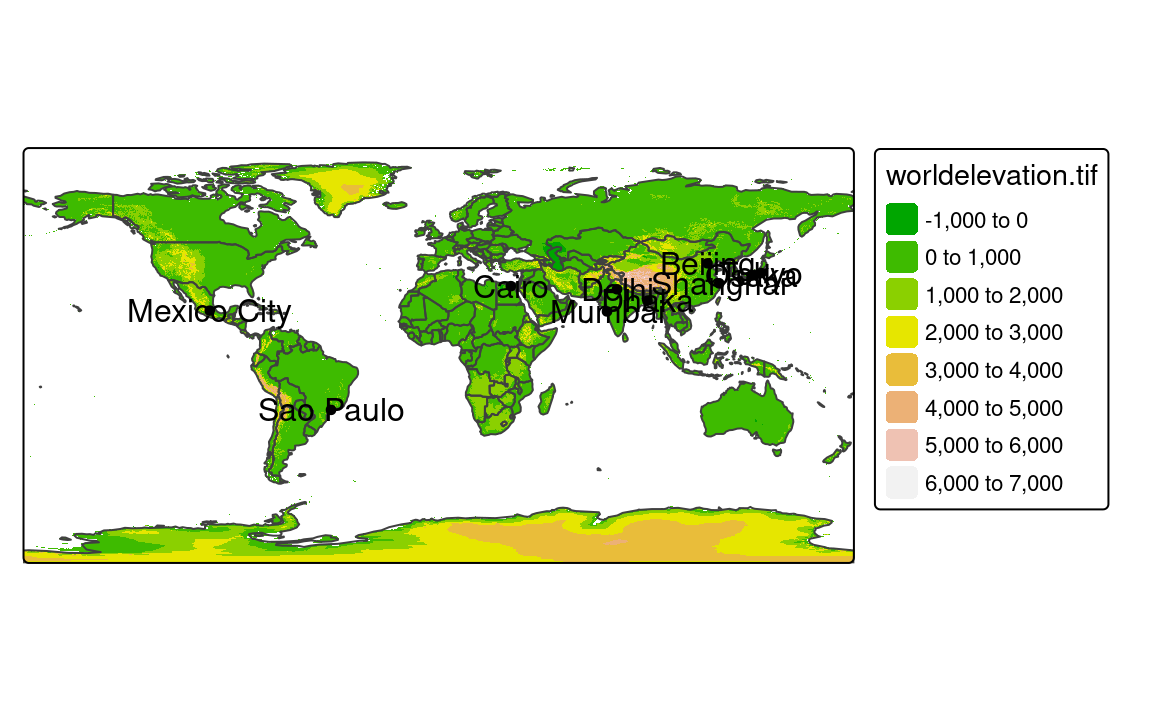
In this example, we use three shapes: worldelevation which is a stars object containing an attribute called "worldelevation.tif", worldvector which is an sf object with country borders, and worldcities – an sf object that contains metropolitan areas of at least 20 million inhabitants.
Each tm_shape() function call is succeeded by one or more layer functions. In the above example, these are tm_raster(), tm_borders(), tm_dots() and tm_text(). We will describe layer functions in detail in the next chapter. For this chapter, it is sufficient to know that each layer function call defines how the spatial data specified with tm_shape() is plotted.
Shape objects can be used to plot multiple layers. In the example, shape worldcities is used for two layers, tm_dots() and tm_text().
5.2 Shapes hierarchy
The order of the tm_shape() functions’ calls is crucial. The first tm_shape(), known as the main shape, is not only shown below the following shapes, but also sets the projection and extent of the whole map. In Figure 5.1, the worldelevation object was used as the first shape, and thus the whole map has the projection and extent of this object.
However, we can quickly change the main shape with the is.main argument. In the following example, we set the worldcities object as the main shape, which limits the output map to the point locations in worldcities (Figure 5.2)2.
tm_shape(worldelevation) +
tm_raster("worldelevation.tif",
col.scale = tm_scale(values = terrain.colors(8))) +
tm_shape(worldvector) +
tm_borders() +
tm_shape(worldcities, is.main = TRUE) +
tm_dots() +
tm_text("name")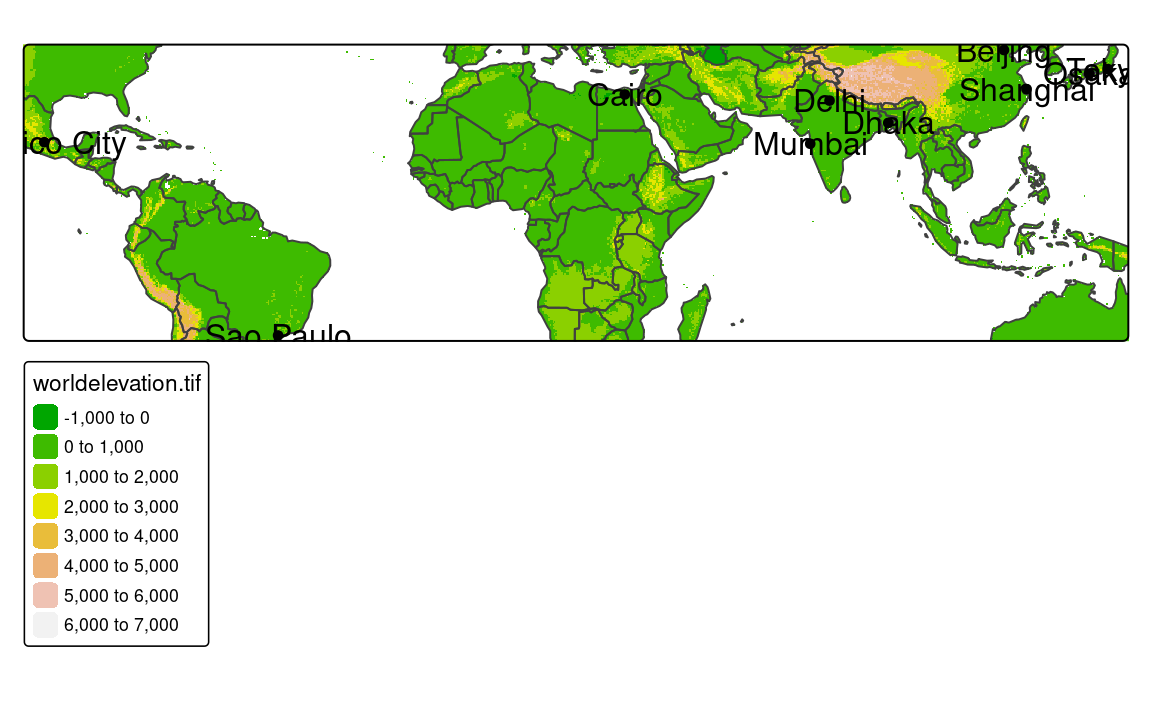
5.3 Map extent
Another important aspect of mapping, besides projection, is its extent – a portion of the area shown in a map. This is not an issue when the extent of our spatial data is the same as we want to show on a map. However, what should we do when the spatial data contains a larger region than we want to present?
Again, we could take two routes. The first one is to preprocess our data before mapping - this can be done with vector clipping (e.g., st_intersection()) and raster cropping (e.g., st_crop()). We would recommend this approach if you plan to work on the smaller data in the other parts of the project. The second route is to specify the map extent in tmap.
tmap allows specifying map extent using three approaches. The first one is to specify minimum and maximum coordinates in the x and y directions that we want to represent. This can be done with a numeric vector of four values in the order of minimum x, minimum y, maximum x, and maximum y, where all of the coordinates need to be specified in the input data units3 In the following example, we limit our map extent to the rectangular area between x from -15 to 45 and y from 35 to 65 (Figure 5.3).
tm_shape(worldelevation, bbox = c(-15, 35, 45, 65)) +
tm_raster("worldelevation.tif",
col.scale = tm_scale(values = terrain.colors(8)))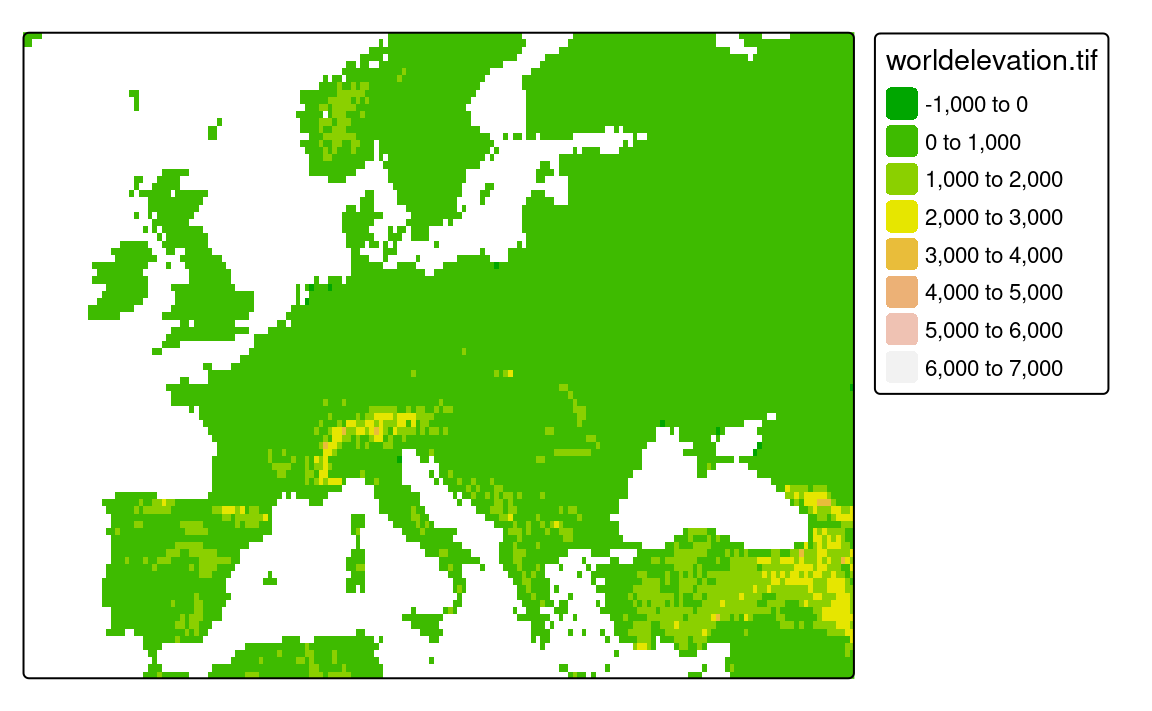
The second approach allows for the map to be set to an extent based on a search query. In the code below, we limit the map extent to the area of "Europe" (Figure 5.4). This approach uses the OpenStreetMap tool called Nominatim to automatically generate minimum and maximum coordinates in the x and y directions based on the provided query.
tm_shape(worldelevation, bbox = "Europe") +
tm_raster("worldelevation.tif",
col.scale = tm_scale(values = terrain.colors(8)))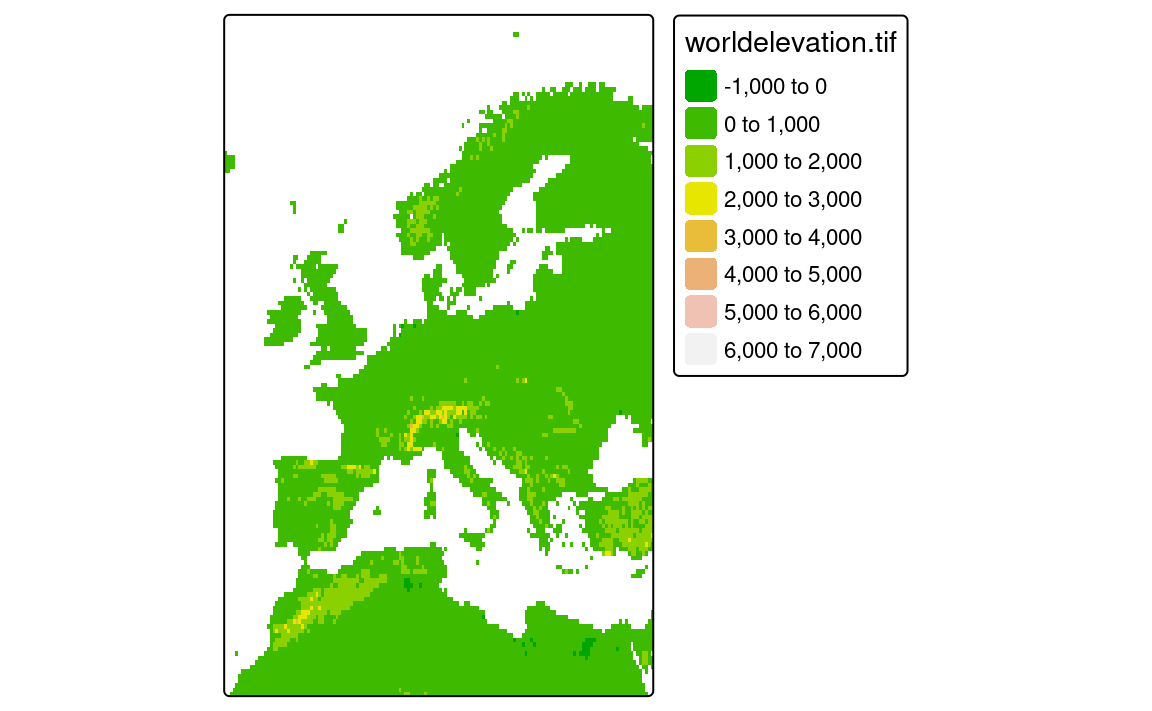
In the last approach, the map extent is based on another existing spatial object. Figure 5.5 shows the elevation raster data (worldelevation) limited to the edge coordinates from worldcities.
tm_shape(worldelevation, bbox = worldcities) +
tm_raster("worldelevation.tif",
col.scale = tm_scale(values = terrain.colors(8)))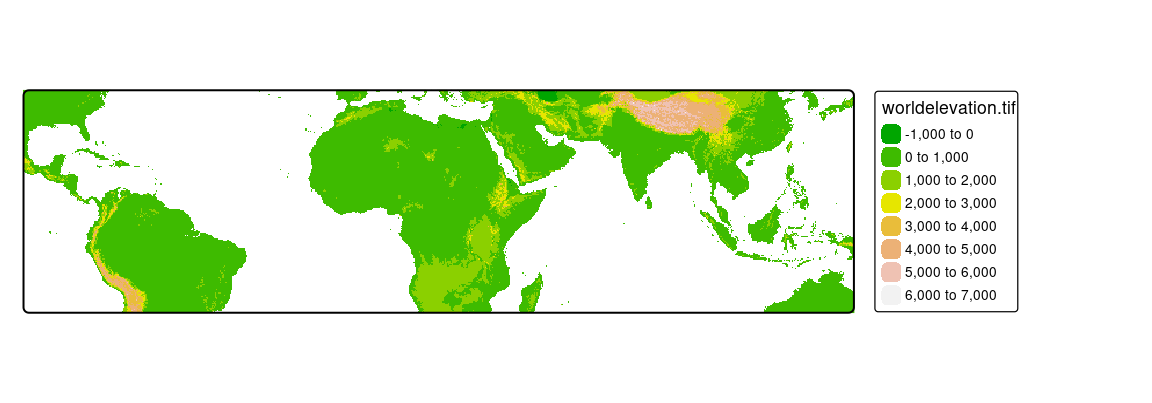
5.4 Map projection
As we mentioned in the previous section, created maps use the projection from the main shape. However, we often want to create a map with a different projection, for example, to preserve a specific map property (Section 2.4). We can do this in three ways. The first way to use a different projection on a map is to reproject the main data before plotting, as shown in Section 2.4.6. The second way is to specify the map projection using the crs argument of tm_shape(). This argument expects either some crs object or a CRS code. The third way is to use a tm_crs() function.
The next code chunks shows all of the three ways, in which we transform the CRS of the worldvector object to "EPSG:8857". This represents a projection called Equal Earth (Šavrič, Patterson, and Jenny 2019). The Equal Earth projection is an equal-area pseudocylindrical projection for world maps similar to the non-equal-area Robinson projection (Figure 2.12).
#1
worldvector8857 = st_transform(worldvector, crs = "EPSG:8857")
tm_shape(worldvector8857) +
tm_polygons()
#2
tm_shape(worldvector, crs = "EPSG:8857") +
tm_polygons()
#3
tm_shape(worldvector) +
tm_polygons() +
tm_crs("EPSG:8857")The first way requires understanding various R packages, as different spatial objects have different functions for changing the projection. The second way is the most straightforward, but it is important to remember that the crs argument can only be set in the main layer (Section 5.2). The third way is the most flexible, as it allows changing the projection for the whole map. Additionally, the tm_crs() function can automatically determine the projection based on the expected property of the map, e.g., equal area ("area"), equidistant ("distance"), or conformal ("shape"). For example, tm_crs("auto") will choose the projection that best preserves the area of the map (Lambert Azimuthal Equal Area), while tm_crs("auto", property = "shape") will choose the projection that best preserves the shape of the map (Stereographic).
Reprojections of vector data are usually straightforward because each spatial coordinate is reprojected individually. Reprojecting of raster data, on the other hand, is more complex and requires using one of two approaches. The first approach applies raster warping, which is a name for two separate spatial operations: creation of a new regular raster object and computation of new pixel values through resampling (for more details read Chapter 7 of Lovelace, Nowosad, and Muenchow (2025)). This is the default option in tmap, however, it has some limitations and it is not always possible to use it.
Figure 5.6 (a) shows the world elevation raster reprojected to Equal Earth. Some of you can quickly notice that certain areas, such as parts of Antarctica, New Zealand, Alaska, and the Kamchatka Peninsula, are presented twice, with one version being largely distorted. Another limitation of raster.warp = TRUE is the use of the nearest neighbor resampling only – while it can be a proper method to use for categorical rasters, it can have some unintended consequences for continuous rasters (such as the "worldelevation.tif" data).
tm_shape(worldelevation, crs = "EPSG:8857") +
tm_raster("worldelevation.tif",
col.scale = tm_scale(values = terrain.colors(8))) The second approach (tm_options(raster.warp = FALSE)) computes new coordinates for each raster cell keeping all of the original values and results in a curvilinear grid. This calculation could deform the shapes of original grid cells, and usually curvilinear grids take a longer time to plot4.
Figure 5.6 (b) shows an example of the second approach, which gave a better result in this case without any spurious lands. However, the creation of the (b) map takes about ten times longer than the (a) map.
tm_shape(worldelevation, crs = "EPSG:8857") +
tm_raster("worldelevation.tif",
col.scale = tm_scale(values = terrain.colors(8))) +
tm_options(raster.warp = FALSE)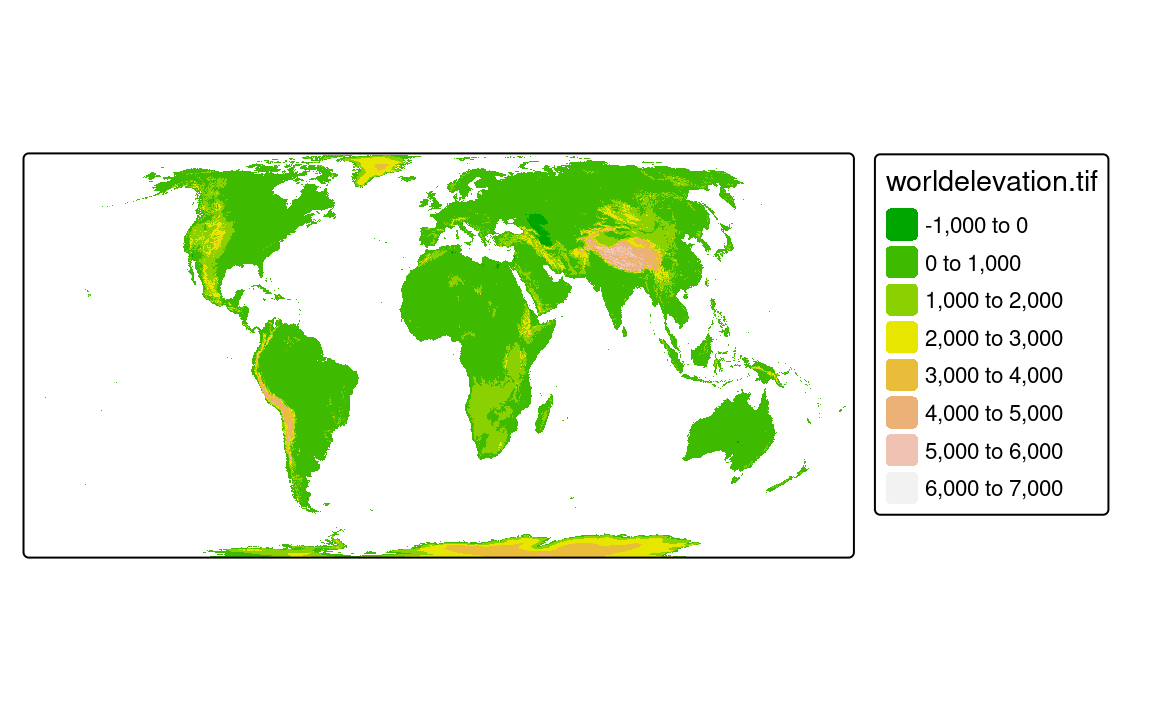
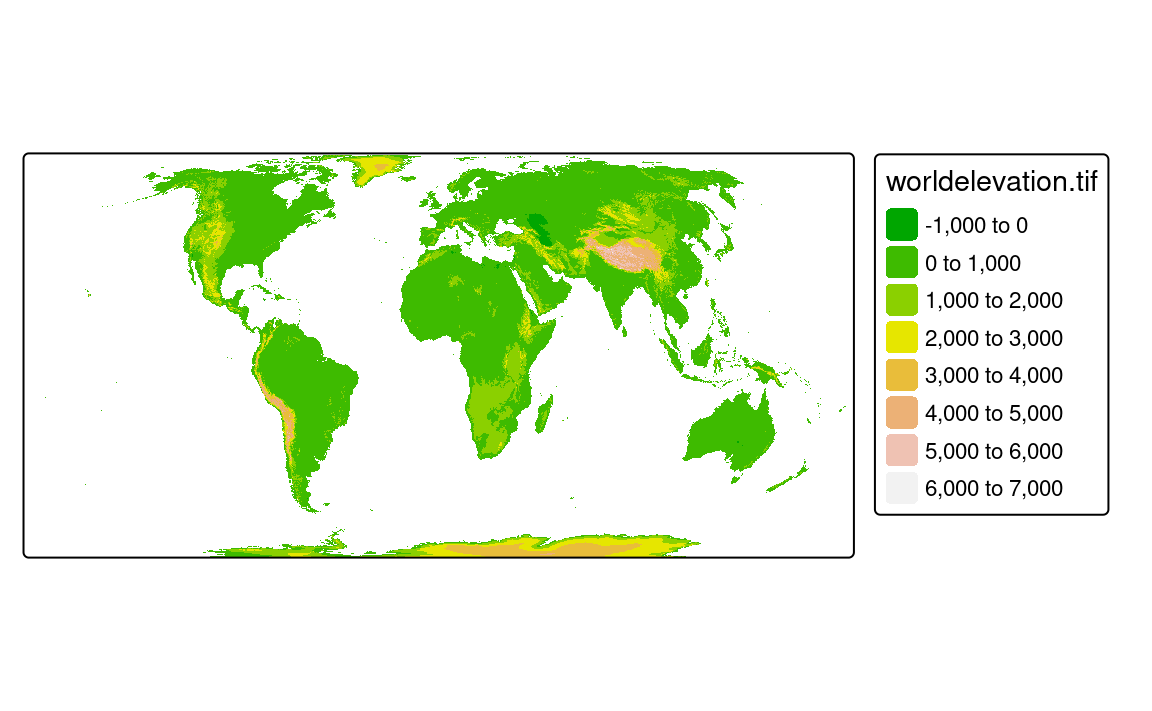
However, tmap also accepts other spatial objects, e.g., of
sp,raster, andterraclasses.↩︎We will show how to adjust margins and text locations later in the book↩︎
This can also be done with the object of class
st_bboxor a 2 by 2 matrix.↩︎For more details of the first approach, see
?stars::st_warp()and of the second approach, see?stars::st_transform().↩︎